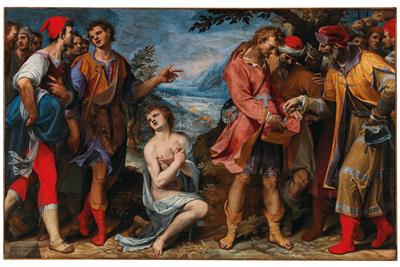Donato Mascagni, called Fra Arsenio

(Florence 1579–1636)
Joseph being sold by his brothers,
signed and dated lower left: DONATO MASCHAG. NI / FACEVA NEL 1602,
oil on canvas, 130.5 x 203 cm, framed
Provenance:
possibly Cardinal Richelieu;
sale, Christie’s, London, 17 November 1950, lot 141 (45 gns to Paez);
sale, Christie’s, New York, 27 January 2010, lot 17 (as Donato Mascagni);
sale, Sotheby’s, New York, 31 January 2013, lot 243 (as Damiano Mascagni);
where acquired by the present owner
Literature:
Dizionario enciclopedico Bolaffi dei pittori e degli incisori italiani, vol. VII, 1983, p. 259;
S. Bellesi, Pittori fiorentini del ‘600 e ‘700, Florence 2009, vol. I, p. 195 (as Donato Mascagni)
The early developments of Donato Mascagni’s own artistic career first emerged in the workshop of the Medici court artist, superintendent of the Medici gallery and Counter-Reformation painter Jacopo Ligozzi (1547–1627). From 1584 until his admission to the prestigious Accademia del Disegno in 1593, Mascagni worked as Ligozzi’s assistant and collaborator for numerous Medici commissions both in fresco and on panel. In the following years he developed a more independent formal pictorial language.
After taking the vows of the Servite Order in 1605, assuming the name Fra Arsenio, Mascagni lived in the monastery at Monte Senario near Florence and later at the Santissima Annunziata in the centre of Florence. Although, he received most of the artistic commissions in Tuscany, Mascagni was also called to work in Rome, Valladolid and Salzburg.
The present signed and dated work was painted by Mascagni in 1602. The split composition shows the dramatic climax of the Old Testament narrative. In the scene depicted, Joseph is sold into slavery by his jealous brothers to a camel caravan, carrying spices and perfumes to Egypt. The kneeling figure takes up the centre of the composition, marking a counterweight to the other figures – notably Joseph is pale-skinned and only partially covered by an azure cloth, creating a connection to the receding landscape in the background, which is composed of various shades of blue. Joseph is flanked by his brothers and merchants, who act as a compositional counterbalance with their darker complexions and upright positions. The harmony of the scenery is dominated by complementary contrasts: the use of different blue and red tones, light and shadow effects, and different hand and head postures which create a sense of movement.
Specialist: Mark MacDonnell
 Mark MacDonnell
Mark MacDonnell
+43 1 515 60 403
mark.macdonnell@dorotheum.at
08.06.2021 - 16:00
- Realized price: **
-
EUR 100,630.-
- Estimate:
-
EUR 80,000.- to EUR 120,000.-
Donato Mascagni, called Fra Arsenio
(Florence 1579–1636)
Joseph being sold by his brothers,
signed and dated lower left: DONATO MASCHAG. NI / FACEVA NEL 1602,
oil on canvas, 130.5 x 203 cm, framed
Provenance:
possibly Cardinal Richelieu;
sale, Christie’s, London, 17 November 1950, lot 141 (45 gns to Paez);
sale, Christie’s, New York, 27 January 2010, lot 17 (as Donato Mascagni);
sale, Sotheby’s, New York, 31 January 2013, lot 243 (as Damiano Mascagni);
where acquired by the present owner
Literature:
Dizionario enciclopedico Bolaffi dei pittori e degli incisori italiani, vol. VII, 1983, p. 259;
S. Bellesi, Pittori fiorentini del ‘600 e ‘700, Florence 2009, vol. I, p. 195 (as Donato Mascagni)
The early developments of Donato Mascagni’s own artistic career first emerged in the workshop of the Medici court artist, superintendent of the Medici gallery and Counter-Reformation painter Jacopo Ligozzi (1547–1627). From 1584 until his admission to the prestigious Accademia del Disegno in 1593, Mascagni worked as Ligozzi’s assistant and collaborator for numerous Medici commissions both in fresco and on panel. In the following years he developed a more independent formal pictorial language.
After taking the vows of the Servite Order in 1605, assuming the name Fra Arsenio, Mascagni lived in the monastery at Monte Senario near Florence and later at the Santissima Annunziata in the centre of Florence. Although, he received most of the artistic commissions in Tuscany, Mascagni was also called to work in Rome, Valladolid and Salzburg.
The present signed and dated work was painted by Mascagni in 1602. The split composition shows the dramatic climax of the Old Testament narrative. In the scene depicted, Joseph is sold into slavery by his jealous brothers to a camel caravan, carrying spices and perfumes to Egypt. The kneeling figure takes up the centre of the composition, marking a counterweight to the other figures – notably Joseph is pale-skinned and only partially covered by an azure cloth, creating a connection to the receding landscape in the background, which is composed of various shades of blue. Joseph is flanked by his brothers and merchants, who act as a compositional counterbalance with their darker complexions and upright positions. The harmony of the scenery is dominated by complementary contrasts: the use of different blue and red tones, light and shadow effects, and different hand and head postures which create a sense of movement.
Specialist: Mark MacDonnell
 Mark MacDonnell
Mark MacDonnell
+43 1 515 60 403
mark.macdonnell@dorotheum.at
|
Buyers hotline
Mon.-Fri.: 10.00am - 5.00pm
old.masters@dorotheum.at +43 1 515 60 403 |
| Auction: | Old Master Paintings I |
| Auction type: | Saleroom auction with Live Bidding |
| Date: | 08.06.2021 - 16:00 |
| Location: | Vienna | Palais Dorotheum |
| Exhibition: | 29.05. - 08.06.2021 |
** Purchase price incl. charges and taxes
It is not possible to turn in online buying orders anymore. The auction is in preparation or has been executed already.
